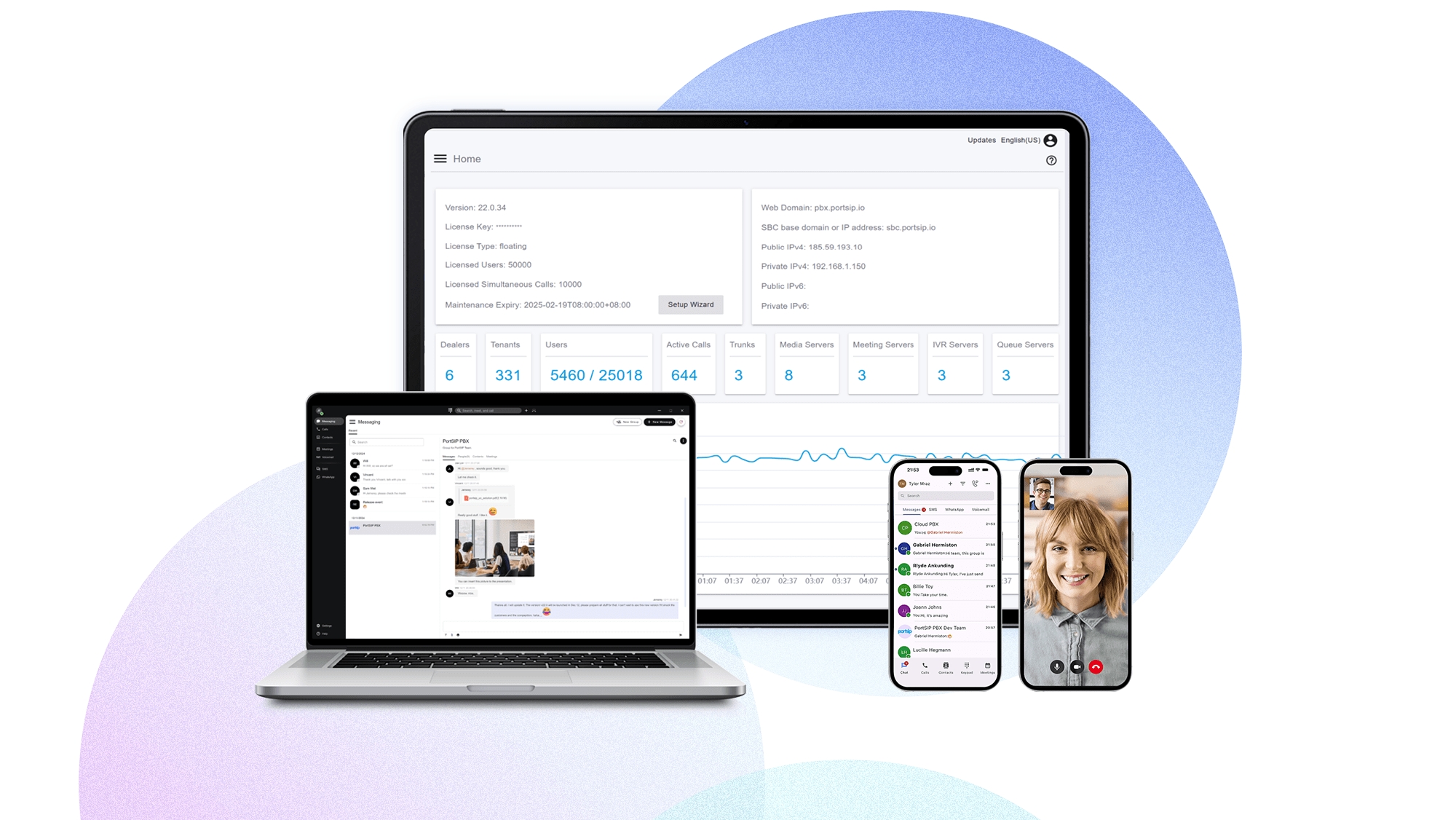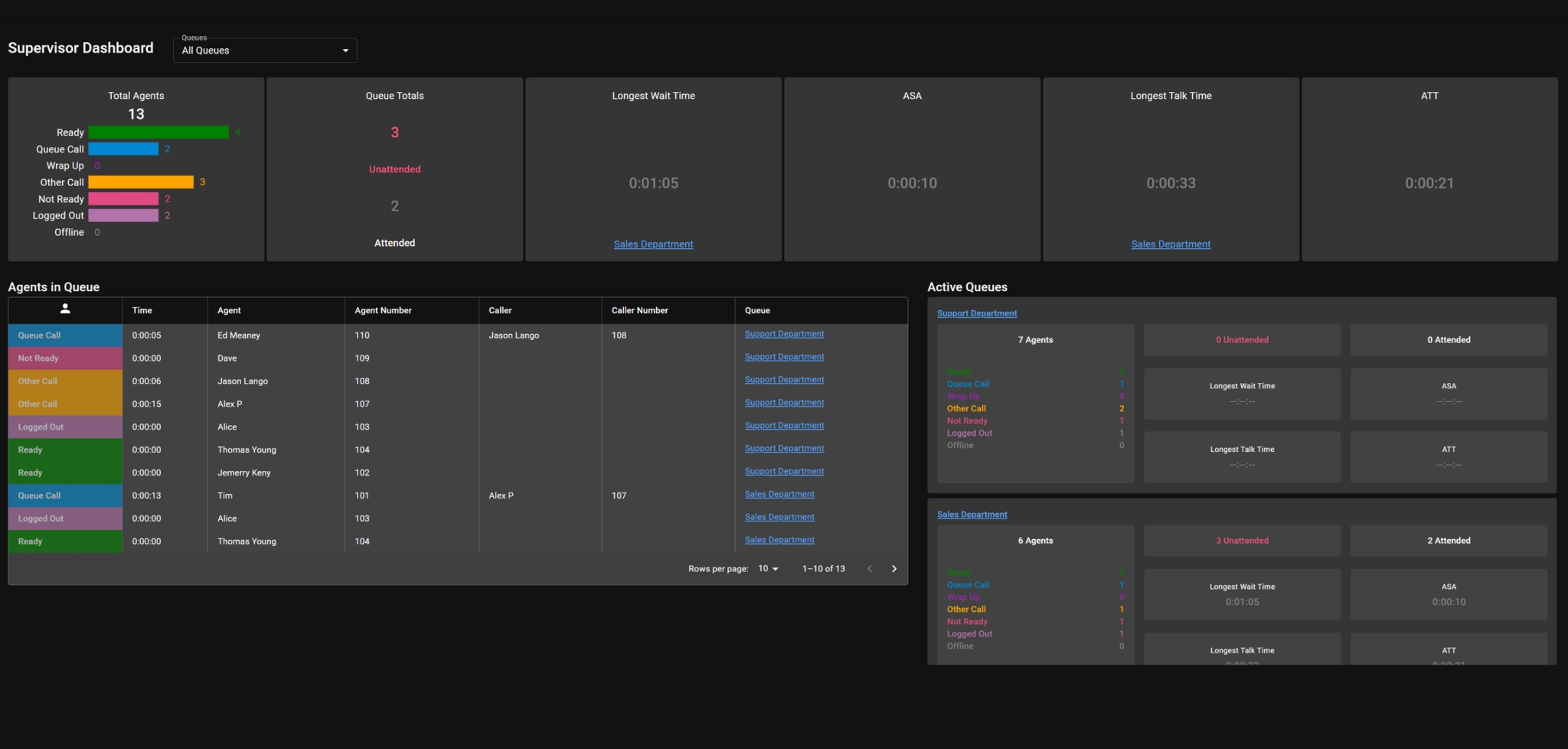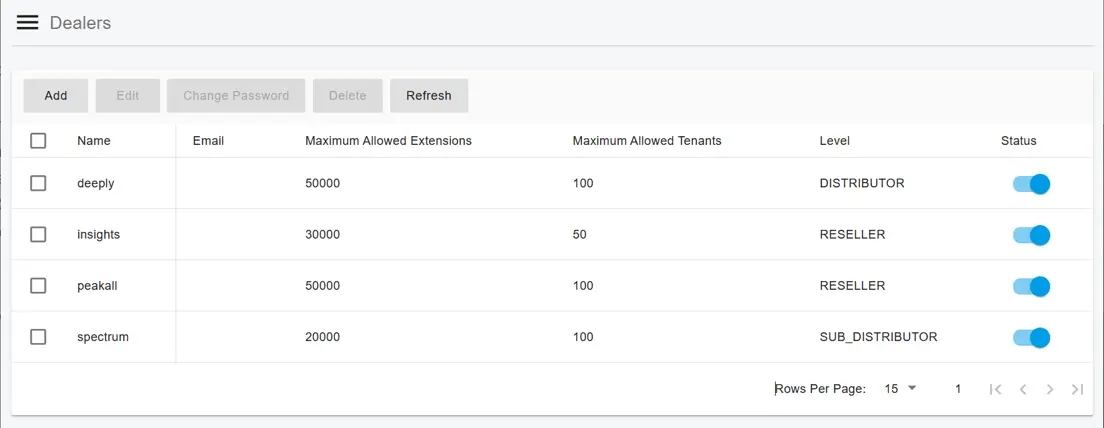The Advantages of PortSIP PBX vs. Other PBXs
The realm of communication technology is rapidly expanding, with modern cloud-based unified communication systems becoming the preferred choice for businesses of all sizes. As traditional phone systems are utilized less and less, organizations are seeking more efficient and versatile communication solutions. The scalability and flexibility offered by contemporary unified communication platforms present significant advantages, especially for those who have adapted to remote and hybrid work models.
Between PortSIP PBX and other PBXs as a business unified communications solution, which would you choose?
This article highlights the advantages of PortSIP PBX compared to other PBX solutions.

PortSIP PBX: A True Multi-Tenant Solution Built for the Cloud Era
While many vendors claim to offer multi-tenant PBX systems, most rely on a pseudo-multi-tenant architecture. Typically, they require setting up a separate PBX instance for each tenant and managing these instances through a centralized web portal. While end-users may not notice, service providers face significant challenges with this approach:
They must maintain a large number of PBX instances.
They waste valuable server hardware resources.
For instance, if a service provider has 1,000 clients, with each client being treated as a separate tenant, each would require its own PBX instance. With tenants typically having between 10 and 50 extensions, the demand on server resources and the maintenance workload becomes overwhelming.
PortSIP PBX offers a genuine multi-tenant solution. Unlike other PBXs that require individual PBX instances per tenant, PortSIP PBX enables service providers to deploy a single instance that can support thousands of tenants. Each tenant has its own configuration and extensions, completely isolated from other tenants, making each one feel as though they have their own dedicated PBX system. This architecture significantly reduces the use of hardware resources and minimizes the effort needed for maintenance, delivering exceptional efficiency for service providers.

As shown in the screenshot, system administrators (service providers) or dealers (distributors, sub-distributors, resellers) can easily view and manage all tenants through the web portal. The following management actions are available:
Add: Create a new tenant.
Manage: Switch to the tenant’s administrator interface to manage extensions, call routing, and other configurations.
Edit: Modify the tenant’s settings, such as adjusting capabilities or feature access.
Disable: Temporarily disable a tenant. All settings and data are preserved and can be reactivated at any time.
Delete: Permanently remove a tenant from the PBX. All data associated with the tenant is erased and cannot be recovered.
This modern multi-tenant PBX architecture is designed for the cloud era, offering flexibility and ease of management. PortSIP has executed this concept exceptionally well, and our clients are reaping the benefits of its streamlined operations and resource efficiency.
Full White-Label Solution
A white-label solution refers to a product or service created by one company, which is then sold by another company under its own branding. Building a strong brand identity can be challenging, but PortSIP makes it easier with a fully customizable white-label PBX and cloud PBX service.
With PortSIP’s rebranding feature, you can fully private label your PBX, making it uniquely yours by customizing the following elements:
Theme
Product Name
Company Name
Website Link
Logo and Favicon
User Agent String of PortSIP PBX and SBC
WebRTC, Windows, and Mobile Apps
IP Phone Templates
Notification Email Templates
This gives you the freedom to focus on marketing, sales, and billing while PortSIP takes care of the technology. For more detailed instructions, please refer to the article on Rebranding PortSIP PBX, SBC.
A Scalable Communications Platform
In a cloud multi-tenant PBX environment, the service provider hosts the PBX in the cloud and delivers calling services to users. Unlike single-tenant PBXs typically used by SMBs, cloud PBXs must manage massive numbers of tenants and simultaneous calls. Ensuring performance and reliability is crucial for the PBX vendor.
PortSIP PBX is specifically designed for the cloud age, offering exceptional performance and scalability. It can easily manage a large volume of extensions (users) and simultaneous calls. For larger deployments, PortSIP PBX can scale by extending the following server components within a cluster:
Queue Server
Meeting Server
IVR Server
Media Server
IM Server
By utilizing this server cluster architecture, the PBX Call Manager server is only responsible for processing signaling. This design, coupled with multi-threading and advanced caching technologies, allows a single PortSIP PBX instance to support up to 100,000 users and 20,000 simultaneous calls. This impressive capability ensures that PortSIP PBX can meet the demands of even the largest service providers.

As shown in the screenshot, we disabled the default media server in the PBX server and extended three additional media servers to efficiently manage a higher volume of calls. This configuration allows the system to handle heavy call loads while maintaining optimal performance and call quality, ensuring the PBX remains scalable and robust even under significant demand.
Designed for High Performance
When designing a cloud PBX, every feature needs to be considered deeply, since it may cause the performance issue when the tenants and users amount is large.
For instance, for the call park feature, as per traditional PBX design, the PBX needs to create a dozen park spots for each tenant. In reality, these spots are PBX extensions that need to register with the PBX and refresh the registration period. The extensions also need to subscribe to these spot extensions for the dialog event in order to receive an alert when a call has been parked on the spot. Additionally, the extensions need to maintain their subscription by sending the SUBSCRIBE message periodically.
Assume each tenant creates 5 park spots, then for a cloud PBX with 1k tenants, there will need to be 5K park spots (extensions) created for the tenants. As mentioned above, these spots are actually PBX extensions. The registration and subscription of these spots will consume massive CPU, memory, and bandwidth resources and reduce cloud PBX performance. This is unacceptable for service providers. It’s hard to imagine if tenants need to create more park spots!
PortSIP pays attention to each feature for multi-tenancy. In order to avoid the problems of traditional PBXs, PortSIP has designed the call parking feature in a unique way that is easy to use and more friendly. It also has good performance and uses fewer resources.
You can find more details in these articles:
Complete Contact Center Solution at no Extra Cost
PortSIP PBX Contact Center solution offers a powerful suite of features to streamline your operations and improve customer interactions. With dynamic call queues, detailed reporting, live wallboards, and integrations with SMS and WhatsApp, customers can reach you through their preferred channels, ensuring seamless communication.
Key Features Include:
Skill-based Routing & Queue Strategies: Optimize call handling for better efficiency and customer satisfaction.
Call-back Options: Never miss a call, and give customers the flexibility they need.
Real-time Monitoring & Training Tools: With features like Listen In, Whisper, and Barge In, supervisors can maintain high service quality with continuous monitoring and real-time coaching.
Live Wallboards: Display real-time data on call queues, agent performance, and more for better team visibility and performance tracking.
SMS & WhatsApp Integration: Engage with customers on their preferred channels, providing fast and efficient communication.
Last Called Agent: Automatically route calls back to the last agent who handled the customer, improving continuity and satisfaction.
VIP Support: Prioritize calls from VIP customers, ensuring they receive immediate attention and a premium service experience.
Exclusive Agent Features: Assign specific agents to handle exclusive customers or certain types of queries, ensuring personalized service and expertise.
Analytics & Reporting: Gain actionable insights with in-depth analytics and customizable reports on call performance, agent productivity, and customer satisfaction metrics.
All of these powerful tools are available at no extra cost—helping you manage your contact center efficiently, without additional licensing fees.

Seamless Migration from BroadSoft
PortSIP PBX offers a rich set of features that distinguish it from other PBX solutions, many of which are similar to BroadSoft, such as Feature Access Codes (dial codes). This similarity ensures a smooth transition for users familiar with BroadSoft systems.
PortSIP PBX's feature access codes closely mirror those of BroadSoft, allowing users to adapt quickly and work more efficiently. Additionally, each tenant can customize their own feature access codes to align with their specific user experience requirements. This flexibility enhances the overall user experience and simplifies the migration process for organizations transitioning from BroadSoft.
For more information, please refer to the article on Feature Access Codes.
Modern Unified Collaboration Solution
PortSIP PBX offers a comprehensive and free collaboration and communication solution tailored for hybrid work environments, enabling inclusive and seamless experiences for all users while safeguarding your data with industry-leading security. It unifies calling, messaging, meetings, and sharing across web, desktop, and mobile apps, providing a truly integrated user experience.
PortSIP PBX offers multiple ways to connect, including:
Audio and Video Calling
Audio and Video Meetings
Messaging
Group Chat
SMS and WhatsApp Integration
Presence
Audio Messaging
Video Messaging
Screen Sharing
File Sharing
Contacts Syncing
CDR Syncing
This unified platform ensures that businesses can efficiently communicate and collaborate, regardless of location, while maintaining secure and flexible connectivity options for their teams.
Effortless User Management
Tenant administrators can easily manage users through the intuitive user list within the PBX web portal. This list provides real-time updates on all extensions, showing their current status—whether online, offline, on a call, push notifications enabled, automatic callback enabled, or Do Not Disturb (DND) enabled. With this clear visibility, administrators can efficiently monitor and manage user activity with minimal effort.

You can click the search icon to view the device details for any online extension. In the example shown below:
Fanvil v65 registered to PBX from 192.168.2.36 on port 5060 via UDP
Snom registered to PBX from 192.168.2.48 on port 35278 via UDP
Grandstream registered to PBX from 192.168.2.107 on port 44862 via UDP
Yealink T42U registered to PBX from 192.168.2.14 on port 5060 via UDP
PortSIP ONE app register to PBX from 192.168.2.71 via UDP
This detailed view enables administrators to easily monitor the devices connected to each extension.

For more information, please refer to the article on User Management.
CDR and Recording
PortSIP PBX supports both audio and video recording and can record calls in MP3 or MP4 format, which makes it easy to play them in the browser.
The CDR is linked with the recording file, which can be downloaded and played in a browser.
The PortSIP CDR feature is different from other PBXs in that if a call is rerouted and forwarded multiple times during the call, the PBX will tie all call targets in one CDR. This makes it easy to track the call flow.


For example, if a call comes from the SIP trunk and arrives at the PBX, then is routed to the IVR and re-routed to the queue by the user pressing DTMF, and an agent of the queue answers that call, all this information(callee number, callee IP address, and port) and timestamp are recorded in the CDR. For more details, please refer to the article on CDR and Call Recording.
Storing Into AWS S3
With PortSIP PBX, you can write your Video Recordings and Compositions to your own AWS (Amazon Web Services) S3 bucket, rather than a local disk. This guide explains how you can set up your own account or project to use this capability. For more details please read this article: Storing into AWS S3.
Privacy
PortSIP PBX also takes care of the privacy of the recording. Due to privacy and security concerns in some countries, the law stipulates that when a call is made between two external numbers, it should not be recorded.
Consider the following scenario: The client calls the contact center from the trunk and the agent answers. The call is starting to be recorded, and after a while of conversation, the agent transfers the client’s call to another landline/mobile phone number, the call is now between two PSTN phone numbers. At this point, the PBX should stop the call recording automatically. PortSIP provides an option for this feature, please read the details in this article: Automatically stop recording if the call between two external numbers.
Trunk Management
Different cloud PBX providers have varying requirements due to their unique business models.
Some providers only host the cloud PBX and do not offer SIP trunks to tenants, requiring tenants to configure their own trunks.
Other service providers offer cloud PBX and SIP trunk bundles, limiting tenant configuration of trunks. In this case, all trunks must be configured by the service provider, who assigns a range of DID numbers (DID pool) to tenants. Tenants can only use the trunk and DID numbers assigned by the service provider to create call routing rules.
Some service providers offer a hybrid mode that allows tenants to configure their own trunks and uses the trunks and DID numbers assigned by the service provider.
PortSIP PBX supports all requirements for service providers to meet their business models. An option called Enable Tenant Level Trunk allows service providers to enable or disable tenant trunk configuration. You can access this option by selecting the menu Advanced > Settings after signing in to the PBX web portal as the system administrator.

For more details, please read the article Trunk Management.
Webhook
PortSIP PBX supports sending the CDR and extension call events to a pre-configured webhook by the tenant admin. This allows the client to integrate the PBX with any third-party system. The webhook is in JSON format. For more details, please read this article: Push CDR to Webhook.
Pub/Sub
PortSIP PBX provides the Pub/Sub mechanism which is based on the WebSocket (PortSIP WSI).
The user is able to create the WebSocket in any programming language to subscribe to the PBX events, once the subscribed events occur, PortSIP PBX will send the event message to the subscriber automatically, the message is in the JSON format. For more details please read this article: Going Real-Time with PortSIP PBX Pub/Sub.
Dealers
The cloud PBX/UC service providers just need to focus on hosting the PBX system in the cloud, ensuring service operation, and providing continuous stable service.
Distributors/Resellers partner of the service providers to give out cloud PBX services and products to the customers.
A distributor or the reseller purchases cloud PBX services and cloud-based PBX products from the cloud service provider and further sells them to the end users.
PortSIP PBX offers a great feature called Dealers for the above scenario that allows service providers to manage dealers (distributors and resellers) easily. For more details please read the article: Dealers.

Flexibility Office Hours and Holidays
PortSIP PBX offers flexible office hours and holiday schedules for tenants located in different countries around the world to meet their local usage. For more details, please read the article: Office Hours and Holiday Schedule.
Free SBC
PortSIP PBX offers a free SBC to support WebRTC and Microsoft Teams Direct Routing. The SBC can be deployed as a cluster to support large calls:
Microsoft 365 Integration
PortSIP PBX seamlessly integrates business communications into your cloud work environment, transforming Microsoft 365 into an enterprise-grade communications hub with a powerful and easy-to-use interface that is simple for end-users to deploy and IT to manage.
For more details, please read this article: Microsoft 365 Integration.
Open REST API
PortSIP PBX provides full REST API which means customers can easily integrate it with any 3rd system.
In fact, the PortSIP PBX Web Portal is also built based on this REST API: PortSIP PBX REST API.
Free PortSIP VoIP SDK for CPaaS
PortSIP offers a VoIP SDK that can be used with PortSIP PBX to create modern UC apps for iOS, Android, Windows, macOS, and WebRTC. It allows the service provider to operate the CPaaS easily.
This award-winning SDK is used by many large companies such as T-Mobile, Nextiva, Qualcomm, Telstra, HPE, Siemens, Netflix, Agilent, and Dialogic: PortSIP VoIP SDK.
Push Notifications
A Voice over Internet Protocol (VoIP) app lets users make and receive phone calls by using an Internet connection instead of the device’s cellular service. Since the VoIP app relies heavily on the network, it’s not surprising that making calls usually results in high power consumption.
PortSIP PBX supports mobile push notifications for iOS and Android apps. All PortSIP users will benefit from this feature, for more details please read this article: How Do Push Notifications Work with PortSIP PBX?
Rebranding App
PortSIP PBX has an app for the below OS:
iOS
Android
Windows Desktop
WebRTC
The apps can be rebranded for free if you purchase the extension license and reach X extensions.
PortSIP PBX Solution Has Your Back
When weighing the solution for hosting the Cloud PBX, you have to look at your needs today and tomorrow. You have to ask yourself where you want to be in the next year or two and beyond.
Here at PortSIP, we’ll walk you through everything, including free porting of your existing solution. We’ll help you select the right VoIP desk phones that meet your client's budget and everyday business needs.
In the age of the cloud, you cannot keep inching along with a legacy PBX. Your traditional PBX solution costs you more than it’s saving.
Take advantage of PortSIP Solution and the freedom to work from anywhere. PortSIP PBX lets you focus on serving your customers, not trying to figure out the system. You can leave the rest to us.
Last updated